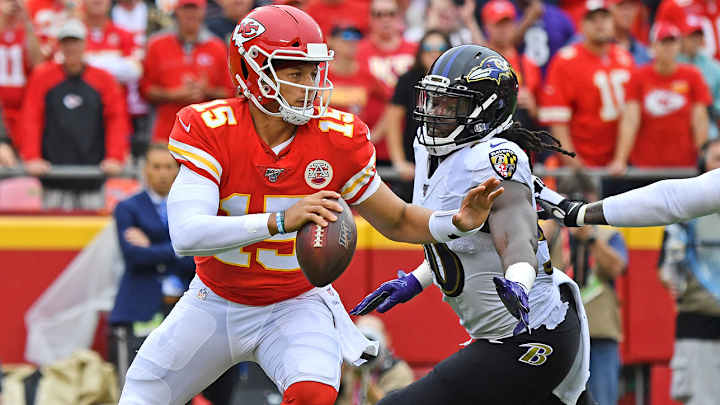Patrick Mahomes and the Chiefs’ Offense Left the Ravens Flustered

Can Patrick Mahomes and the Chiefs offense be stopped?
If you posed that question to John Harbaugh, he’d answer “No.” Tacitly, the Ravens head coach said everything he needed to about Mahomes and the Chiefs with the decision he made after RB Mark Ingram’s one-yard touchdown early in the fourth quarter on Sunday—his third of the day.
More than 12 minutes remained in regulation and after Ingram’s score, Baltimore was still trailing 30–19. The in-game coaching manual says to kick the PAT and make it a 10-point game, a no-brainer. But Harbaugh, as he’d done earlier after his team’s first touchdown, went for two. A coach generally does that for one of two reasons: either he doesn’t like the team’s chances should the game go to overtime, or more likely, he doesn’t think the defense can hold the Chiefs scoreless for those final 12 minutes. A successful two-point try would give the Ravens 21, leaving them still (technically) within two scores should Kansas City find the end zone and go up 37–21.
It’s also possible that Harbaugh simply made an uncharacteristic error in judgement. Either way, the point is the same: Patrick Mahomes and his juggernaut offense takes you out of your game. The Ravens have long been one of football’s stingiest, most aggressively defensive-minded teams. Since making Lamar Jackson their starting quarterback last year, they have posted well over 200 yards rushing per contest. And so a veteran head coach with a smashmouth defense and dominant ground game chose to go the shootout route in Kansas City, attempting three fourth downs in the first half and a pair of “unnecessary” two-point conversion attempts. Coming in, the Ravens were very aware that the Chiefs had scored at least 26 points in each of its last 21 outings. Baltimore chose to go the shootout route because they figured Kansas City would take them there anyway.
This introduces unchartered territory for how a QB can impact a game. Plenty of teams over the years have taken more chances when facing the likes of Tom Brady, Peyton Manning or any other star quarterback. But usually those are teams with so-so defenses that are already built for offensive shootouts. The Ravens, again, have a smashmouth defense and perhaps the league’s most dominant rushing attack.
Ultimately, Harbaugh’s aggression didn’t succeed, as Baltimore lost to Kansas City 33–28—but that doesn’t mean it was the wrong approach. For one, because of their ground game, the Ravens probably figured that going for fourth-down conversions and touchdowns instead of field goals would also keep the clock moving with Mahomes on the sideline. Still, you don’t commit so fully to this approach unless you trust your quarterback and, more importantly, fear your opponent’s. What we’ll never know is whether Harbaugh would have played so aggressively if Joe Flacco were still his quarterback. Jackson’s unique playmaking ability gives the Ravens more gameplanning freedom.
Of course, Jackson was, by a wide margin, just the second-best quarterback at Arrowhead on Sunday. He missed on a few of the vertical throws that he hit in Weeks 1 and 2, and his legs, though scintillating, could not make up the difference. Contrast that with Mahomes, who connected on a handful of downfield bombs both by design and out of structure.
That ability to play both within the designs and out of structure is what makes Mahomes’s lethality unparallelled. Brady, Manning and most of the other superstar QBs of this era have been dependent on winning within structure. Opponents would be less likely to gamble with an aggressive gameplan like Harbaugh’s because during the week, they could tell their players (and themselves) that if we just do this, this and THIS, we can combat Brady’s or Manning’s offensive system and at least give ourselves a chance. It should be noted that Mahomes runs an even more intricate, explosive system than Brady or Manning ever ran. And even if you take him out of it, he’s almost just as dangerous—and in some ways, maybe even more dangerous—thanks to his second reaction playmaking ability.
The only QBs in recent memory who could truly thrive playing either on-schedule OR off-schedule are Ben Roethlisberger and Aaron Rodgers—and both have spent their careers running systems that are elementary compared to what Mahomes executes in Kansas City. Plus Mahomes, with his amazingly pliable arm, is a far more dangerous off-schedule thrower than Roethlisberger and even Rodgers—who is the most dangerous off-schedule thrower of all time. It’s terrifying that Mahomes is not dependent on off-schedule plays.
Through three games, the NFL’s reigning MVP looks even better than last year. The Chiefs’ offense is humming even without its primary weapon, Tyreek Hill. Last week, when it often didn’t hum against the Raiders’ unexpected man coverage, Mahomes still put up points, mainly by heaving near-perfect balls downfield against tight one-on-one coverage. The Ravens adopted many of those same man coverage principles on Sunday, and Mahomes made them pay. And those payments only grew when the Ravens brought pressure or played zone. Mahomes has 10 touchdowns and no interceptions through three games. His 1,195 yards so far are the fourth most in NFL history. The fact that he’s 24 years old is even more mesmerizing, as it suggests he’s only scratching the surface of his potential. John Harbaugh won’t be the last coach to roll the dice with an aggressive, uncharacteristic gameplan against K.C.
Question or comment? Email us at talkback@themmqb.com.
